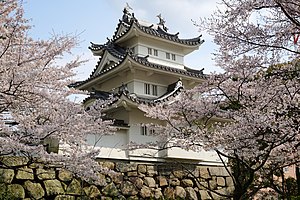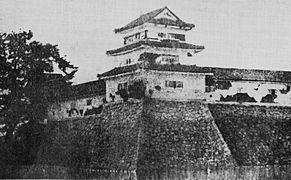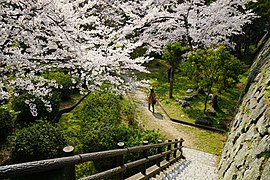Tsu Castle
| Tsu Castle | ||
|---|---|---|
|
Ushitora watchtower, 1958 |
||
| Alternative name (s): | Anotsu Castle | |
| Creation time : | after 1571 | |
| Castle type : | Hirayamajiro (hill castle) | |
| Conservation status: | Partly reconstructed | |
| Place: | Tsu | |
| Geographical location | 34 ° 43 '4 " N , 136 ° 30' 27.6" E | |
|
|
||
The Castle Tsu ( Japanese 津城 , Tsu-jō ) is located in the city of Tsu in Mie Prefecture . In the Edo period , the Tōdō last resided there as the great Tozama daimyō .
Lords of the castle in the Edo period
- From 1600 Tomita Nobutaka ( 富田 信 高 ; † 1633) with an income of 50,000 Koku .
- From 1609 the Tōdō with 220,000 Koku.
history
Tsu Castle was previously called Anotsu ( 安 野 津 ). From here the traffic on the coast could be monitored. The castle, built from 1571 by Oda Nobukane ( 織田 信 包 ; 1548–1614), a brother of Oda Nobunagas , then fell to Tomita Nobutaka as vassal Toyotomi Hideyoshis , who Tokugawa Ieyasu left there until Tōdō Takatora became lord of the castle in 1606 . This extended the castle considerably until 1616.
investment
Protected in the north by the river Anō ( 安 濃 川 , -gawa ) and in the south by the Iwata ( 岩田 川 , -gawa ), the castle was secured further inside by two ring-shaped moats.
The access to the central castle area, the Hommaru ( 本 丸 ), was protected by two island-shaped structures, one in the northwest ( 西 の 丸 , Nishi-no-maru ) and another in the southeast ( 東 の 丸 , Higashi-no-maru ). In the southwest corner of the Hommaru you can see the base for a large and a small castle tower ( 天 守 閣 , tenshukaku ), but the towers were never built. Instead, a watchtower was built at the other corners of the Hommaru and two more were built on the sides. The name Ushitora watchtower ( 丑 寅 櫓 , Ushitora-yagura ) after the twelve branches of the earth indicates the position in the northeast corner. Correspondingly, the three-story watchtower on the northwest corner was called Inui watchtower ( 戌 亥 櫓 , Inui-yagura ). He took on the role of the castle tower. The Tsukimi watchtower ( 月 見 櫓 , Tsukimi-yagura ) stood at the southeast corner, so it is not named after the branches of the earth. Because then it would have been called Tatsumi watchtower ( 辰 巳 櫓 , Tatsumi-yagura ).
The walls show a straight, somewhat flatter rise at the base, which is referred to as "dog run" ( 犬 走 り , inu-hahsiri ). Takatora already used this construction method when building Imabari Castle .
In 1871 the castle buildings were demolished and the central part was converted into a public park. A Japanese style garden was laid out in the Hommaru. The gate to the former Han school Yūzōkan ( 有 造 館 ) was moved here as the entrance gate to the garden . It bears the name "entrance gate to virtue" ( 入 徳 門 , Nyūtoku-mon ). In 1958 the Ushitora watchtower was rebuilt, but more complex than the original and not marked in yellow on the original wall corner in the plan of the castle, but offset in brown to the southeast entrance, the former Higashikurogane-mon ( 東 鉄 門 ).
photos
literature
- Hashiba, Akira: Tsu-jo in: Miura, Masayuki (Ed.): Shiro to jin'ya. Saikoku-hen. Gakken, 2006. ISBN 978-4-05-604379-2 .
- Nishigaya, Yasuhiro (Ed.): Tsu-jo. In: Nihon meijo zukan, Rikogaku-sha, 1993. ISBN 4-8445-3017-8 .








